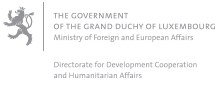- Home
- Preface
- European Year for Development
- COP21 and the Paris Agreement
- I. Luxembourg’s official development assistance in 2015
- II. Cooperation with the main partner countries
- III. Regional cooperation and cooperation with other countries
- IV. Multilateral cooperation
- V. European Union
- VI. Cooperation with non-governmental development organisations
- VII. Humanitarian action
- VIII. Programme support
- IX. Development education and awareness raising
- X. Inclusive finance
- XI. Evaluation
- XII. Report on the progress of the work of the Interministerial Committee for Development Cooperation
- Appendices
VII. Humanitarian action

Emergency food aid is transported by air in some parts of South Sudan, where access by road is limited, due to conflicts and rains © PAM
Emergency aid
In terms of emergency aid, 2015 was marked by the simultaneous existence of four level 3 humanitarian crises – level 3 being the highest level of humanitarian crisis – in Syria, central Africa, South Sudan, Iraq and Yemen. In May 2015, the level 3 humanitarian crisis category for the crisis in the Central African Republic was withdrawn, while in July 2015 the humanitarian crisis in Yemen was classified as level 3. As a result, the emergency funds from the humanitarian budget for 2015 were mainly allocated against the background of these level 3 crises and also the complex, prolonged crisis in Mali and in the Lake Chad region.
The dramatic situation in Syria entered its fifth year in 2015: according to the United Nations it is the most serious humanitarian crisis of the last fifty years. The Syrian crisis has been a level 3 humanitarian crisis since 15 January 2013. On 31 March 2015, at the third pledging conference for Syria in Kuwait, Luxembourg announced it would be making a contribution of 5,5 million euros (made up of 5 million euros in humanitarian aid and 500 000 as development assistance) to respond to the needs of the population in Syria and the Syrian refugees in Turkey, Jordan and Lebanon in 2015. By mid-September 2015, Luxembourg had already honoured that commitment. The contribution enabled various humanitarian partners to implement projects to benefit the affected population on Syrian soil as well as the over 3 million Syrian refugees in neighbouring countries (Lebanon, Jordan and Turkey).
Following the conflict that has been ravaging South Sudan since December 2013, in February 2014 the international humanitarian system classified the country as a level 3 humanitarian crisis. During the high-level international meeting on the humanitarian situation in South Sudan which took place on 16 June 2015 in Geneva, Luxembourg announced a promise to donate 2,4 million euros to South Sudan for 2015. At the end of September 2015, the promised donation was even exceeded through a total contribution of 2 690 126 euros to the International Committee of the Red Cross, NGOs and UN agencies intervening in the fields of health, water, hygiene and sanitation, food aid, emergency shelter, telecommunications services and emergency services in various parts of South Sudan.
The Ministry has also supported emergency aid projects run by the Red Cross and Red Crescent movement, NGOs and UN agencies in the following countries: Afghanistan, Algeria, Bangladesh, Burundi, Italy (refugees), Iraq, Lesotho, Mali, Malawi, Nepal, Niger, Nigeria, Pakistan, Philippines, Central African Republic, Republic of Congo, Democratic Republic of Congo (DRC), Somalia, Sudan, Sri Lanka, Swaziland, Occupied Palestinian Territories, Chad, Thailand, Ukraine, Vanuatu, Yemen and Zimbabwe.
Response to humanitarian needs in the Lake Chad Basin region
The humanitarian situation in the Lake Chad Basin region has greatly deteriorated due to the violence perpetrated by the Boko Haram group. According to OCHA, some 2,7 million people, half of which are children, have been displaced in the region. This is the fastest-growing displacement crisis in Africa. In 2015, the Ministry allocated 1 202 000 euros to projects in Niger, Nigeria and the region in general. This meant that the World Food Programme was able to supply vital support to households in Cameroon, Chad and Niger directly affected by the insecurity in northern Nigeria. The ICRC received support for its programme in Nigeria which provides protection and assistance to people affected by armed conflict and violence, especially in the north-east of the country, the central countries and those in the Niger delta. The NGOs CARE in Luxembourg, the Luxembourg Red Cross and Caritas Luxembourg have, with the Ministry’s support, been able to carry out emergency projects to benefit refugees, internally displaced people and host populations in the Diffa region in Niger.

